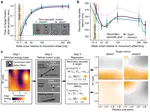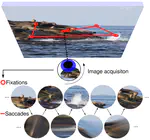object correspondence
In this piece we showed that the visual traces that moving objects induce during saccades can facilitate secondary saccades in both accuracy and saccade initiation latency. Secondary saccades are typically prompted when one saccade does not entirely reach a target or when the saccade target is displaced in mid-flight. Our results provide evidence against the widely acknowledged notion that our brains preemptively discard visual information which reaches the eye during saccades. The paper has received some peer and media attention, such as a well-written commentary by Jasper Fabius and Stefan van der Stigchel, as well as articles in Nature Research Highlights, AAAS, New Scientist, or Vozpópuli (see the Rolfslab's blog post for the full list). Notably, this study is the first one to apply the new TrackPixx eye tracking system, for which I have written a Matlab toolbox.
Is intra-saccadic vision merely an epiphenomenon or could visual information that reaches the eye during saccades be used by the visual system? That was the question of my cumulative doctoral dissertation, which features not only a synopsis of all studies conducted up to this point, but also a review of the saccadic-suppression and motion-streak literature to put these findings into context. The dissertation has been awarded two prizes – the Humboldt Prize and the Lieselotte Pongratz-Promotionspreis by Studienstiftung des Deutschen Volkes (see also the short movie).
Whenever we make a saccade to an object, that object will travel from the periphery to the fovea at extremely high velocities. Depending on the visual features of the object, such motion can induce streaks, that may serve as visual clues to solve the problem of trans-saccadic object correspondence. Using a high-speed projection system operating at 1440 fps, we investigated to what extent human observers are capable of matching pre- and post-saccadic object locations when their only cue was an intra-saccadic motion streak, and compared their performance during saccades to a replay of the retinal stimulus trajectory presented during fixation. Note that a toolbox for parsing Eyelink EDF files was implemented in R to analyze this series of experiments, which can be found here.


